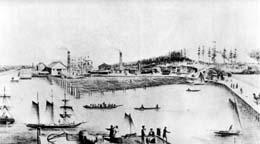In July 1853, Captain William C. Talbot (1816-1881) establishes a steam sawmill as the Puget Mill Co. at Port Gamble. Ten men, mostly from Talbot's hometown of East Machias, Maine, construct a bunkhouse, a cookhouse, and a store before starting work on the mill. The site is on a sand spit the local Native Americans call Teekalet, meaning "brightness of the noonday sun." The settlers call the mill Teekalet until they change the name to Port Gamble in 1868. The mill will operate continuously for 142 years, from 1853 to 1995.
Captain Talbot was a partner of Andrew J. Pope (1820-1878) in San Francisco where they unloaded ships and imported and sold lumber. When they learned of the vast timber resources of Puget Sound, they joined with Josiah Keller (d. 1862) in November 1851 to build and operate a "Steam Saw Mill for manufacturing lumber in Oregon in the vicinity of Puget Sound" (Coman, 35). They returned to their home in East Machias, Maine, to obtain workers and supplies. In East Machias, they added Charles Foster to the enterprise, which they called the Puget Mill Company. In Maine, they recruited employees and obtained equipment and supplies to start and sustain the mill and they left for the Pacific Coast in two small sailing ships.
Talbot captained the small, 50-ton schooner Julius Pringle from East Machias to San Francisco and Puget Sound by way of Cape Horn. His voyage took 171 days. The East Machias men aboard the Julius Pringle included:
- E.S. Brown - millwright
- James White - machinist and engineer
- Nathaniel Harmon
- Hillman Harmon
- David Foster
- Cyrus Walker
Talbot reached Discovery Bay on the Olympic Peninsula and anchored. Wanting to choose the best site for a sawmill, he set out in a sailboat to explore Hood Canal. The captain detailed Cyrus Walker to take an Indian canoe down Puget Sound. Walker and his Indian guides paddled as far as Vashon Island past Henry Yesler's steam sawmill at Seattle.
Talbot took his sailboat up Hood Canal. He saw that Port Ludlow was an ideal location for a mill, but another mill operator had taken that location. Talbot spotted the sandspit at the mouth of Port Gamble and judged it ideal. The spit had room enough for a mill and other buildings, plentiful supplies of "Oregon Pine" (Douglas fir), and the spit sheltered sailing ships from the prevailing winds.
Talbot landed 10 employees and they built a bunkhouse, a cookhouse, and a store to trade with the natives and settlers. Talbot had also brought from Maine cut lumber for the buildings, which were roofed with local shakes. The foundation timbers for the mill came from trees at the head of the bay.
Talbot's first shipment of lumber from Puget Sound did not come from the Teelaket Mill however. Captain Talbot purchased pilings from Henry Yesler at Seattle in September 1853. On his way back to San Francisco, near Port Townsend, Talbot encountered the L.P. Foster with his partner Josiah Keller aboard. The L.P. Foster was a clipper schooner, and it had carried the mill machinery and merchandise for the store around Cape Horn from Maine. Talbot told Keller of the site selected for their mill. Keller landed with his wife and a daughter and he took charge of the operation.
In September 1853, within a week of landing the engine, boilers, and a Muley saw, Keller had steam up and he and the Takeelet crew cut its first log. On September 24, 1853, even before the mill was ready, Keller inserted an item in the weekly Columbian (Olympia) with a list of the goods in the store and an offer to cut lumber.
Keller died at Victoria, B.C., in 1861, which dissolved the partnership. Pope and Talbot settled with Keller's heirs and bought out Foster's interest. Pope and Talbot then formed a partnership that included the Puget Mill Co.
The sawmill at Port Gamble operated continuously from 1853 until 1995.

